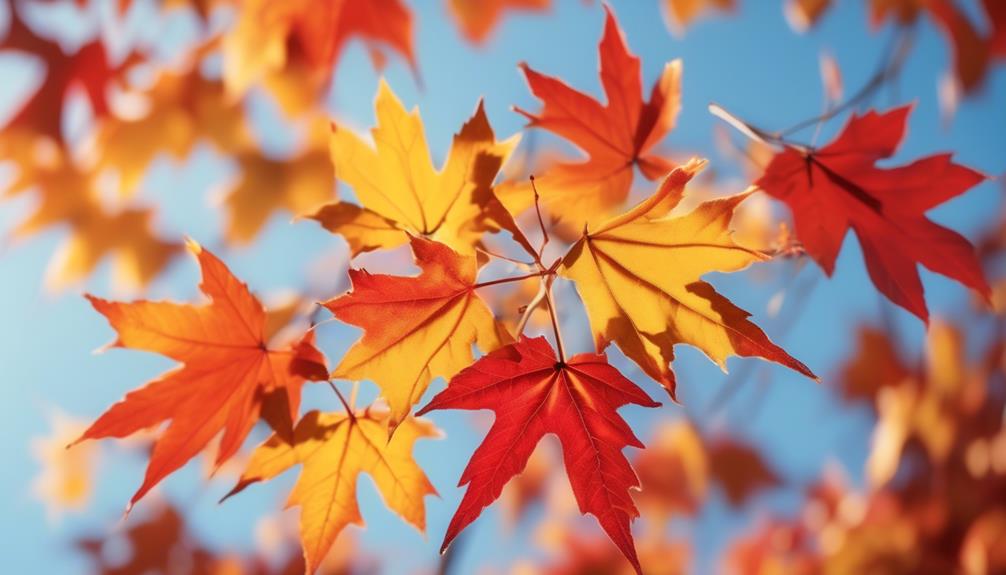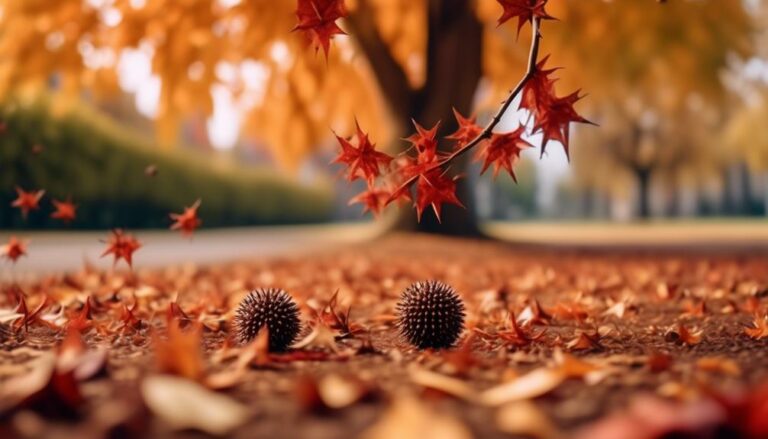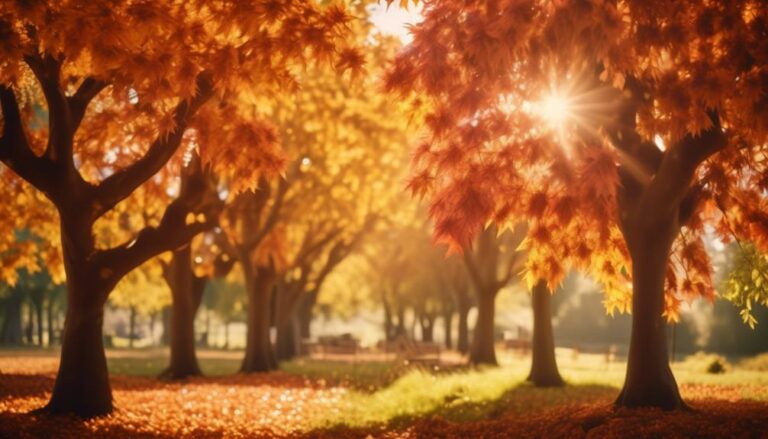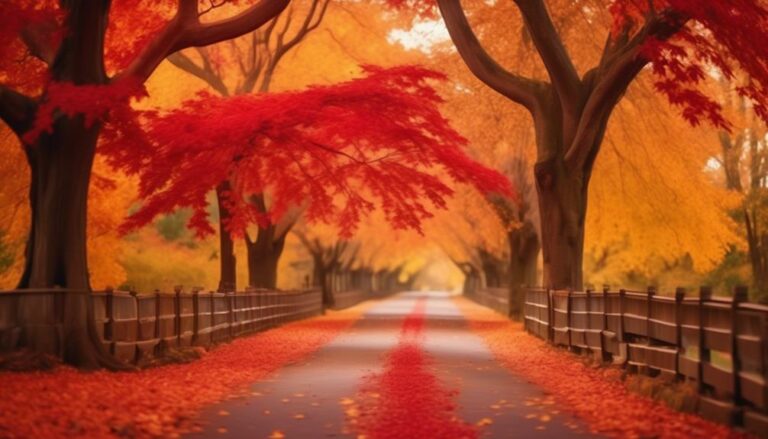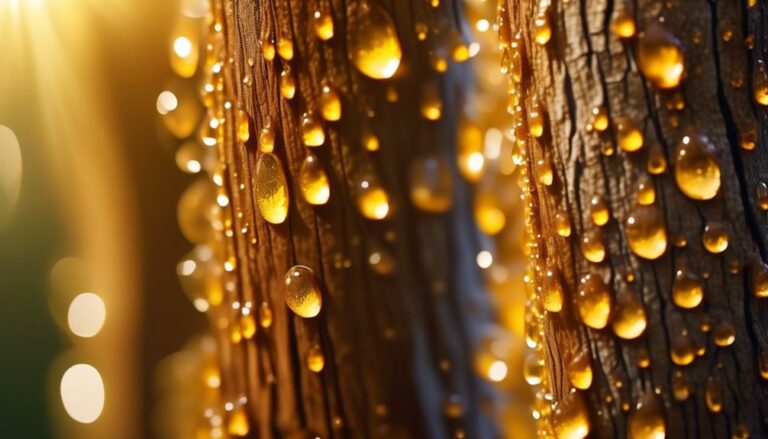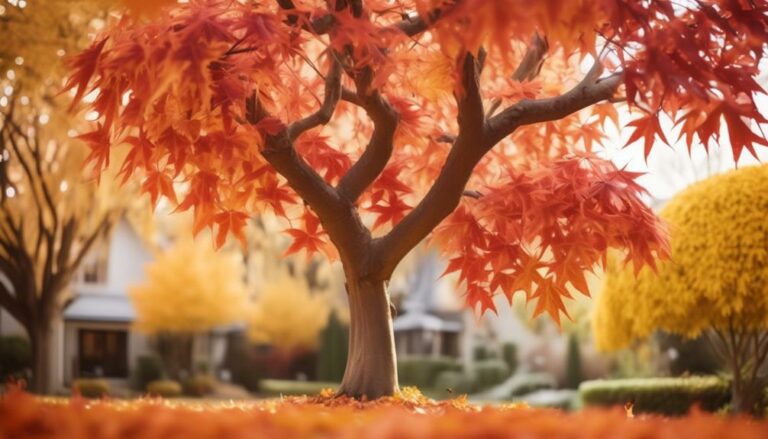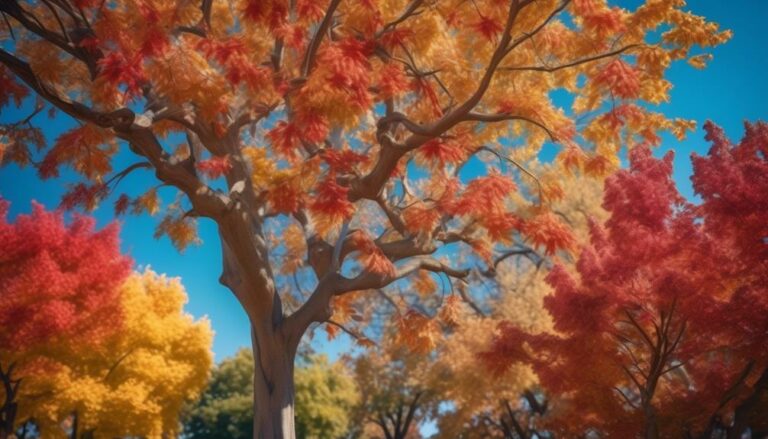What Are Effective Tips for Capturing Vibrant Fall Foliage on Liquidambar Trees?
Imagine walking through a picturesque autumn landscape, surrounded by a tapestry of vibrant colors. The air is crisp, and the leaves on the Liquidambar trees are ablaze with hues of red, orange, and gold.
You want to capture this breathtaking scene, but where do you start? In this discussion, we will explore effective tips for capturing the vibrant fall foliage on Liquidambar trees, providing you with the knowledge and techniques needed to bring the stunning beauty of these trees to life in your photographs.
So, whether you're a seasoned photographer or just starting out, get ready to discover the secrets to capturing the essence of fall on these majestic trees.
Timing Is Key
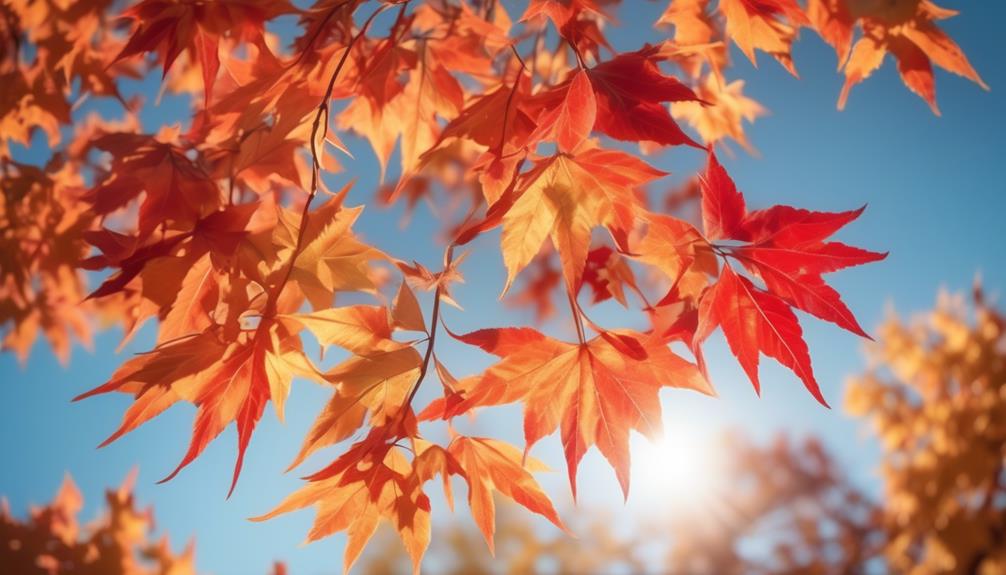
Timing is crucial when it comes to capturing vibrant fall foliage on Liquidambar trees. Make sure to plan your photography outings based on the Fall Foliage Prediction map and local forecasts. The peak of fall colors on Liquidambar trees typically occurs in late October to early November, but it can vary depending on the region and weather conditions.
To maximize your chances of capturing the most vibrant foliage, use satellite imagery and trip reports to accurately time your outings. Keep an eye on the lighting conditions and weather, aiming to shoot during the golden hour for warm, soft light that enhances the red and orange hues of the leaves. Overcast days can also provide even lighting and saturated colors.
Understanding the science behind fall foliage, including the role of chlorophyll and the transition of colors, can help you anticipate and capture the most vibrant moments as the leaves turn.
Choosing the Right Equipment
To capture vibrant fall foliage on Liquidambar trees, it's essential to choose the right equipment. Start by using a DSLR or mirrorless camera for better image quality. These cameras allow you to capture the colors of the fall foliage with more vibrancy and detail.
Additionally, bring a wide-angle lens to capture expansive landscapes and showcase the full beauty of the Liquidambar styraciflua trees. If you want to isolate specific details or capture wildlife, make sure to utilize a telephoto lens. It will allow you to zoom in and capture those intricate details.
To ensure sharp images in low light conditions, always use a tripod. This will prevent any blurriness caused by camera shake.
Lastly, don't forget to pack extra batteries and memory cards for longer shooting sessions. By following these tips, you'll be well-equipped to capture the vibrant colors of fall foliage on Liquidambar trees.
Finding the Perfect Location
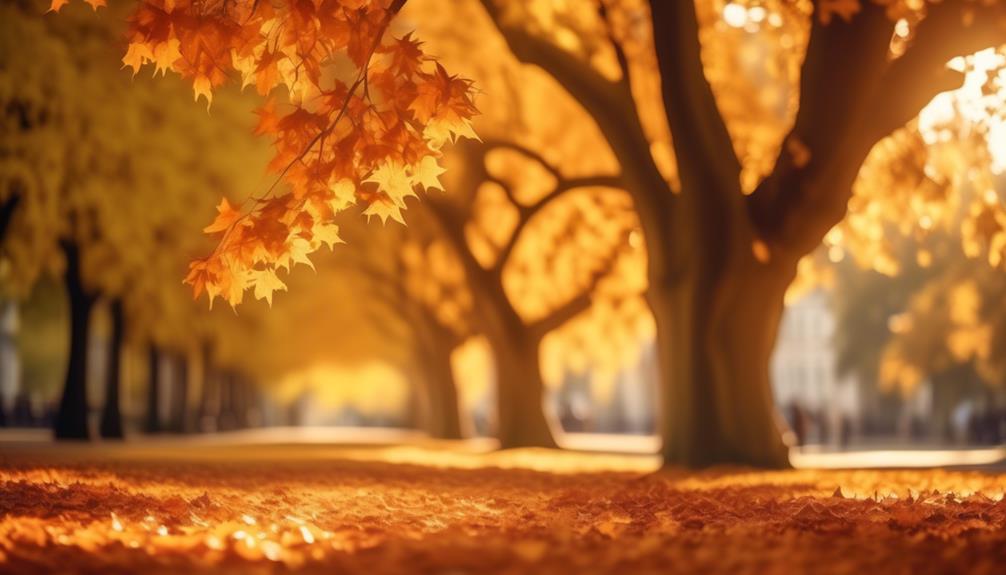
To capture vibrant fall foliage on Liquidambar trees, you'll need to find the perfect location. Look for ideal shooting spots where the foliage is especially vibrant and colorful.
Consider the angles and perspectives that will enhance your photos and create visually appealing compositions.
Ideal Shooting Spots
For the ideal shooting spots to capture vibrant fall foliage on Liquidambar trees, explore and research different locations known for their diverse tree species and stunning array of colors. Look for areas with a variety of trees that display vibrant autumn colors, such as maples, oaks, and birches. These diverse species will create a more visually appealing composition with a range of colors.
Consider the accessibility and safety of the location, ensuring that you can easily move around and position yourself for the best shots. It's also important to check for any restrictions or permits required for photography in the area.
Locating Vibrant Foliage
To locate vibrant foliage for capturing stunning fall foliage on Liquidambar trees, utilize various resources such as fall foliage prediction maps, local forecasts, satellite imagery, trip reports, and your own knowledge as an amateur naturalist.
Start by checking the Fall Foliage Prediction map provided by smokymountains.com. This will give you an estimate of the right time for vibrant foliage in your area.
Additionally, search for a local fall colors forecast from media outlets and land managers to find the perfect location.
Gaia GPS satellite imagery can also help you accurately time fall foliage peaks in potential photography locations.
Don't forget to read trip reports on AllTrails.com to get updated foliage status in different areas.
Best Angles for Photos
After locating the vibrant foliage on Liquidambar trees, it's time to find the perfect location to capture stunning fall foliage by exploring the best angles for photos.
To capture the essence of the orange foliage and enhance its beauty, consider the following tips:
- Experiment with different perspectives: Try shooting from low angles to showcase the height of the trees and create a sense of grandeur.
- Look for diverse foliage and unobstructed views: Find locations that offer a variety of colorful leaves and ensure there are no obstacles blocking your view, allowing you to create dynamic compositions.
- Play with framing and contrast: Seek out vantage points that allow you to frame the vibrant foliage against contrasting backgrounds, such as the sky or other trees. This will add depth and visual interest to your photos.
Mastering Composition Techniques
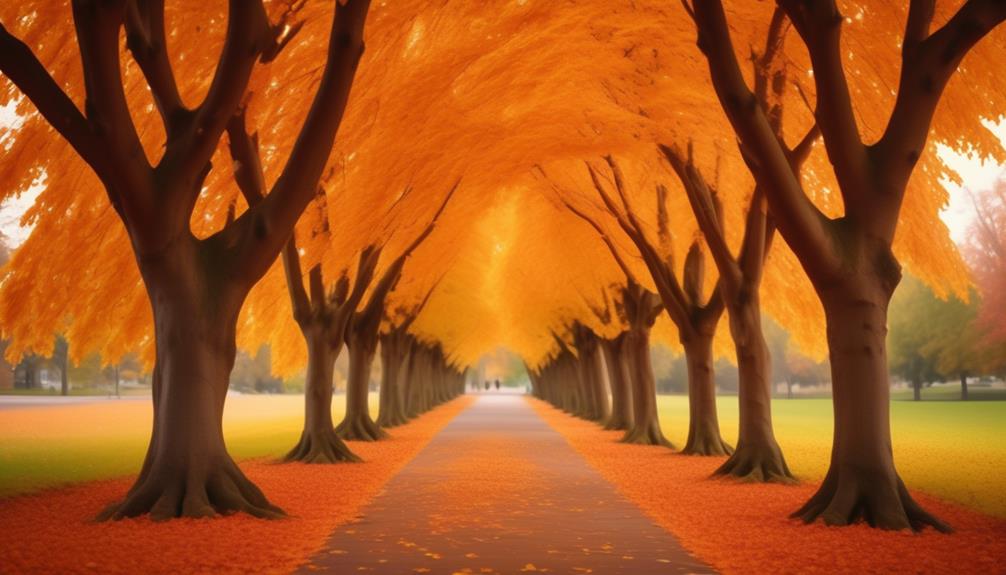
To capture vibrant fall foliage on liquidambar trees, you need to master composition techniques that enhance the visual impact of your photos.
Experiment with different angles and perspectives to create unique compositions that highlight the beauty of the foliage.
Utilize leading lines to guide the viewer's eye through the image and create a sense of depth.
Additionally, apply the rule of thirds to achieve a balanced and visually pleasing composition.
Rule of Thirds
Master composition techniques and create visually stunning photographs by incorporating the rule of thirds in your images of Liquidambar trees during the vibrant fall foliage season. The rule of thirds is a fundamental principle in photography composition that can help you capture captivating images of native trees with their deep red leaves, providing a stunning contrast against the autumn landscape as the days grow shorter.
Here's how you can effectively use the rule of thirds with Liquidambar trees:
- Balance and harmony: Place key elements like the tree trunk or branches along the intersecting points of the grid to create a balanced composition.
- Experiment with angles: Try different perspectives and angles to find unique compositions that draw the viewer's eye into the image.
- Guide the viewer's eye: Use the rule of thirds to lead the viewer's gaze through the image towards the vibrant fall foliage, creating a visually engaging composition.
Leading Lines
As you continue to explore composition techniques for capturing vibrant fall foliage on Liquidambar trees, one powerful tool to consider is the use of leading lines.
Leading lines are lines within the frame that guide the viewer's eye through the image, creating a sense of depth and visual interest. Incorporating leading lines in your fall photography can enhance the beauty of the orange foliage on these red oak trees.
Experiment with different angles and perspectives to create unique compositions. To create a balanced and visually pleasing image, you can also use the rule of thirds.
Additionally, pay attention to color contrast and complementary colors to make your photos impactful. By incorporating leading lines, you can capture the beautiful fall scenery on Liquidambar trees with added depth and dimension.
Working With Lighting and Weather
For optimal results, consider shooting during the golden hour or on overcast days to capture the vibrant fall foliage on liquidambar trees.
The soft, warm light during the golden hour enhances the colors of the leaves, making them appear even more vibrant. On overcast days, the clouds act as natural diffusers, creating even lighting and saturated colors.
To add a glowing effect to the leaves and foliage, try backlighting them by positioning yourself so that the light is coming from behind.
Be prepared for changing weather conditions and have protective gear, as fall weather can be unpredictable.
Experiment with different lighting conditions to create different moods in your photos.
Whether you're capturing the iconic Sugar Maple with its vibrant red leaves, the Ginkgo trees with their golden hues, or the Japanese Maple with its fiery red foliage, the right lighting can make all the difference in bringing out the beauty of the fall leaves.
Utilizing Different Angles and Perspectives
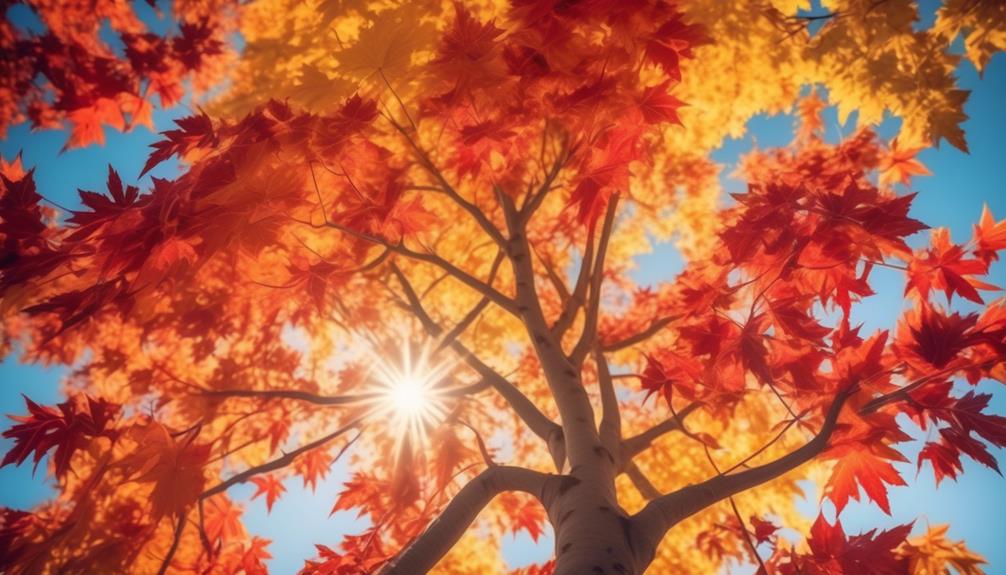
To capture the vibrant fall foliage on Liquidambar trees in unique and captivating ways, experiment with different angles and perspectives. Consider shooting from low angles to capture the colorful leaves against the sky, adding depth and drama to your photos.
By shooting from above, you can capture the canopy of the Liquidambar tree, showcasing the vibrant foliage from a bird's eye view. Utilize close-up shots to focus on the intricate details of the foliage, capturing the rich textures and patterns from a different perspective.
Don't forget to incorporate wide-angle shots to capture the entire tree and its surroundings, showcasing the stunning fall foliage in its natural environment.
Highlighting Colors and Textures
Enhance the vibrant colors and textures of fall foliage by utilizing the soft, warm light of the golden hour. This magical time of day, just after sunrise or before sunset, bathes the trees in a gentle glow, enhancing the essence of fall.
To capture the beauty of vibrant shades and textures, try these techniques:
- Experiment with backlighting: Position yourself so that the sunlight shines through the leaves, creating a glowing effect and emphasizing the textures.
- Incorporate foreground elements: By adding objects in the foreground, such as branches or fallen leaves, you can add depth and dimension to your photos, accentuating the colors and textures of the foliage.
- Pay attention to color contrast: Look for complementary colors or contrasting elements in the scene to make the vibrant fall foliage pop in your photographs.
Remember to explore different angles and perspectives to capture the diverse textures of leaves, branches, and bark.
With these techniques, you can create stunning images that showcase the beauty of the fall season.
Capturing the Details
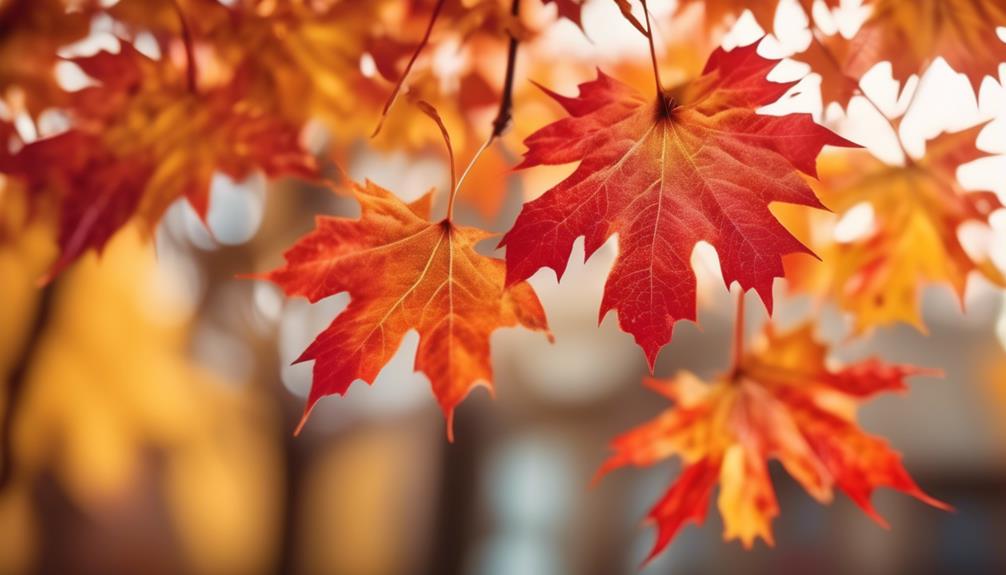
Get up close and personal with the leaves to capture the intricate patterns and textures of the foliage. To truly appreciate the beauty of the fall foliage, you need to pay attention to the details.
Take the time to observe the purple leaves of Sweetgum trees and the vibrant shades of red maples. Experiment with different angles and perspectives to capture the unique textures and shapes of the leaves. Consider using a macro lens to showcase the fine details, such as the intricate veins and vibrant colors.
By focusing on individual leaves or small clusters, you can highlight the beauty of the foliage up close. Look for interesting lighting conditions, like backlighting or diffused light, to further enhance the colors and textures.
Don't miss out on capturing the intricate details of the foliage in the fall.
Experimenting With Different Camera Settings
Now it's time to play around with different camera settings to enhance your fall foliage photos.
Start by adjusting the aperture to create color contrast and make the vibrant leaves pop against the background.
Experiment with different shutter speeds to capture movement, whether it's the wind blowing through the trees or leaves falling to the ground.
Lastly, fine-tune your ISO settings to achieve optimal exposure and avoid any under or overexposed areas in your shots.
Aperture for Color Contrast
Experimenting with different aperture settings allows you to control the depth of field and bring out the vibrant color contrast in your fall foliage shots. By adjusting the aperture, you can create stunning images of Liquidambar styraciflua trees, capturing the beauty of the colorful leaves against the backdrop of the changing season.
Here are three tips for using the aperture to enhance color contrast in your photographs:
- Use a wider aperture (lower f-stop number) to create a shallow depth of field. This will isolate the colorful leaves, making them stand out against a blurred background.
- Try a smaller aperture (higher f-stop number) to achieve a greater depth of field. This will ensure that both the vibrant foliage and the surrounding environment are in sharp focus.
- Utilize aperture priority mode to easily adjust the aperture while the camera sets the corresponding shutter speed. This allows for proper exposure and ensures that the colors are accurately captured.
Shutter Speed and Movement
To capture movement and create various effects in your fall foliage photos, it's important to experiment with different shutter speeds. Adjusting the shutter speed allows you to freeze the motion of leaves in a breeze, capturing crisp details with a faster speed.
On the other hand, using a slower shutter speed can create a sense of motion and fluidity in the falling leaves, adding a dynamic feel to your images. To achieve a smooth and dreamy flow of foliage, try experimenting with long exposures.
Find the perfect balance between freezing action and conveying the essence of autumnal movement in your liquidambar tree captures. By playing with shutter speeds, you can enhance the vibrancy and beauty of fall foliage in your photographs.
ISO for Optimal Exposure
Adjusting the ISO setting on your camera allows you to experiment with different levels of light sensitivity, enhancing your ability to capture vibrant fall foliage on liquidambar trees (Liquidambar styraciflua).
To achieve optimal exposure and capture the brilliant golden-yellow leaves of the liquidambar tree, consider the following tips:
- Use a lower ISO setting, such as 100 or 200, in bright, well-lit conditions. This will help capture crisp details with minimal noise.
- Increase the ISO to 400, 800, or higher in low-light situations to maintain proper exposure and prevent blurry images.
- Find the balance between higher ISO settings and increased digital noise. Experiment with different ISO settings to understand how they affect the overall exposure and image quality in varying lighting conditions.
Post-Processing Tips for Stunning Results
For stunning results in post-processing, enhance the warmth and vibrancy of fall foliage by adjusting the white balance. This will bring out the vibrant shades of red, orange, and yellow that are characteristic of the season.
Selective color adjustments can also be used to make the foliage pop against the background, creating a captivating visual effect.
Increasing the clarity and contrast will help bring out the texture and details of the leaves, making them appear more vivid and lifelike.
Experimenting with vignetting can draw attention to the central foliage and create a captivating focal point.
Additionally, utilizing graduated filters can balance the exposure and enhance the overall composition of the image.
Conclusion
In conclusion, capturing vibrant fall foliage on Liquidambar trees requires careful planning and attention to detail.
By timing your photography session to coincide with peak colors, choosing the right equipment, and finding the perfect location, you can create stunning images.
Mastering composition techniques, working with lighting and weather conditions, and highlighting colors and textures will further enhance your photos.
Don't forget to experiment with different camera settings and utilize post-processing techniques for truly stunning results.
Happy photographing!

